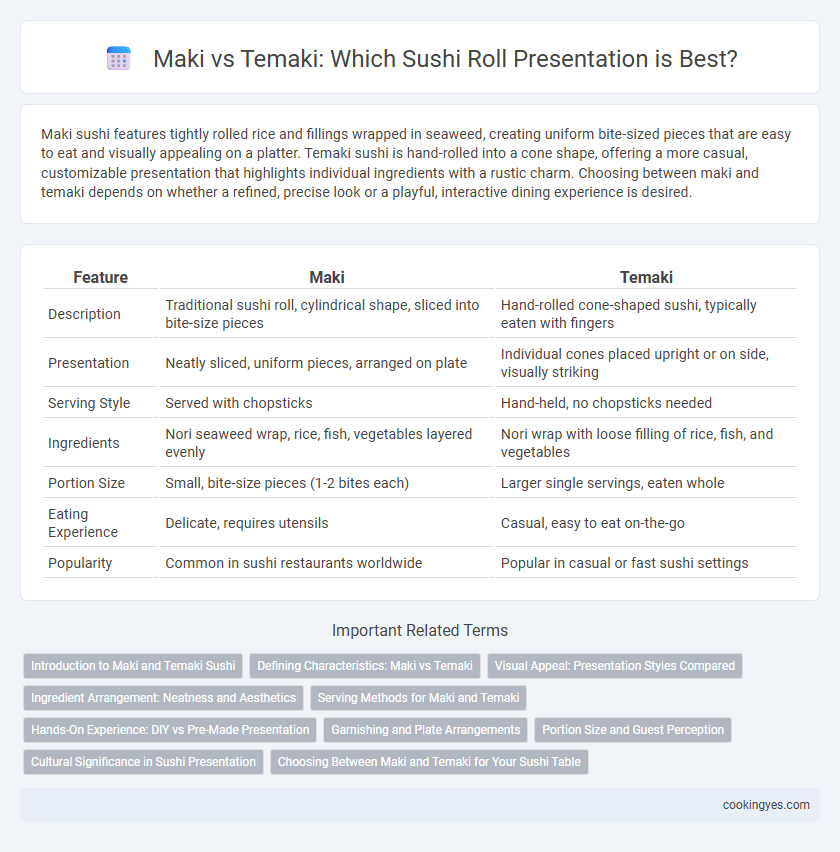Maki sushi features tightly rolled rice and fillings wrapped in seaweed, creating uniform bite-sized pieces that are easy to eat and visually appealing on a platter. Temaki sushi is hand-rolled into a cone shape, offering a more casual, customizable presentation that highlights individual ingredients with a rustic charm. Choosing between maki and temaki depends on whether a refined, precise look or a playful, interactive dining experience is desired.
Table of Comparison
| Feature | Maki | Temaki |
|---|---|---|
| Description | Traditional sushi roll, cylindrical shape, sliced into bite-size pieces | Hand-rolled cone-shaped sushi, typically eaten with fingers |
| Presentation | Neatly sliced, uniform pieces, arranged on plate | Individual cones placed upright or on side, visually striking |
| Serving Style | Served with chopsticks | Hand-held, no chopsticks needed |
| Ingredients | Nori seaweed wrap, rice, fish, vegetables layered evenly | Nori wrap with loose filling of rice, fish, and vegetables |
| Portion Size | Small, bite-size pieces (1-2 bites each) | Larger single servings, eaten whole |
| Eating Experience | Delicate, requires utensils | Casual, easy to eat on-the-go |
| Popularity | Common in sushi restaurants worldwide | Popular in casual or fast sushi settings |
Introduction to Maki and Temaki Sushi
Maki sushi features bite-sized rolls wrapped in nori seaweed, typically sliced into pieces, creating a visually appealing presentation ideal for communal dining and easy consumption. In contrast, Temaki sushi is a hand-rolled cone-shaped creation, allowing for a more rustic and casual serving style that highlights fresh ingredients in a single, convenient portion. Both Maki and Temaki showcase the versatility of sushi rolls, catering to different dining experiences and presentation preferences.
Defining Characteristics: Maki vs Temaki
Maki sushi features tightly rolled nori seaweed wrapped around vinegared rice and various fillings, usually sliced into bite-sized pieces for easy consumption. Temaki sushi, or hand rolls, are cone-shaped with nori wrapped around rice and fillings, designed for hand-held eating without slicing. The structured, uniform presentation of maki contrasts with the casual, open-ended form of temaki, emphasizing convenience versus traditional aesthetics.
Visual Appeal: Presentation Styles Compared
Maki rolls showcase a uniform, cylindrical shape with evenly sliced pieces, emphasizing symmetry and a clean, elegant presentation ideal for formal dining. Temaki, or hand rolls, offer a cone-shaped, casual look with visible, vibrant fillings that create a dynamic and engaging visual contrast. The compact, bite-sized maki pieces provide a refined aesthetic, while temaki's playful, open structure highlights the freshness and texture of ingredients in a more approachable style.
Ingredient Arrangement: Neatness and Aesthetics
Maki sushi features ingredients evenly layered and tightly rolled within nori, creating a uniform, cylindrical shape that showcases clean, symmetrical cross-sections when sliced. Temaki sushi presents ingredients spiraled loosely in a cone-shaped nori wrap, allowing for a more casual, open display of colorful fillings that emphasize natural texture and freshness. The precise, neat arrangement in maki enhances visual symmetry, while temaki's artistic, freeform presentation highlights ingredient variety and vibrancy.
Serving Methods for Maki and Temaki
Maki sushi is traditionally served in neatly sliced rolls arranged on rectangular platters, enhancing visual appeal and portion control. Temaki sushi is hand-rolled into cone shapes, typically presented individually or standing upright in special holders to maintain structure and ease of handling. These distinct serving methods highlight the formal presentation of Maki versus the casual, interactive style of Temaki.
Hands-On Experience: DIY vs Pre-Made Presentation
Maki sushi rolls offer a pre-made presentation with uniform, bite-sized pieces ideal for elegant plating and easy sharing, while Temaki provides a hands-on, DIY experience where each cone-shaped roll is individually assembled, allowing for customization and interactive dining. The preparation of Temaki engages diners directly, making it a popular choice for social gatherings and personal creativity in ingredient selection. Maki emphasizes precision and consistency, enhancing visual appeal and making it suitable for formal settings or professional sushi presentations.
Garnishing and Plate Arrangements
Maki sushi features tightly rolled rice and fillings wrapped in seaweed, allowing for precise garnishing like thinly sliced vegetables or edible flowers neatly arranged on each piece, enhancing visual appeal on flat plates. Temaki sushi's cone shape offers a dynamic presentation, with garnishes such as sesame seeds, roe, or microgreens accentuating the open end, creating height and texture on larger, more artistic plates. Plate arrangements for maki favor uniform rows or circular patterns, while temaki benefits from staggered or clustered placement to emphasize its hand-roll style and vibrant garnishing details.
Portion Size and Guest Perception
Maki sushi rolls typically offer smaller, uniform portions that appeal to guests seeking bite-sized, visually consistent servings, enhancing the overall presentation and ease of consumption. Temaki, or hand rolls, present larger, cone-shaped portions that emphasize a casual, interactive dining experience, often perceived as more generous and customizable by guests. Portion size in Maki fosters a refined and elegant impression, while Temaki's size and shape highlight abundance and individuality in sushi presentation.
Cultural Significance in Sushi Presentation
Maki and Temaki sushi rolls reflect distinct cultural values in Japanese cuisine, with Maki emphasizing precision and uniformity through its neatly sliced, bite-sized pieces, symbolizing harmony and balance. Temaki, or hand rolls, showcase a more casual and interactive dining experience, aligning with social sharing traditions and individual expression in sushi presentation. The cultural significance of these forms lies in their representation of different dining contexts--formal settings for Maki and informal, personal enjoyment for Temaki.
Choosing Between Maki and Temaki for Your Sushi Table
Maki rolls offer a neat, uniform presentation ideal for formal settings and easy portion control, with each piece showcasing consistent fillings wrapped in seaweed and rice. Temaki, or hand rolls, provide a casual and interactive dining experience, featuring cone-shaped sushi that highlights vibrant ingredients and encourages personalization at the table. Selecting between maki and temaki depends on the desired aesthetic and guest engagement, balancing structured elegance against playful spontaneity.
Maki vs Temaki for sushi roll presentation Infographic

 cookingyes.com
cookingyes.com